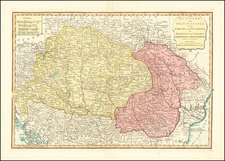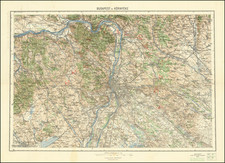The Battle That Saved Civilization
Fine example of the second state of Antonio Lafreri's map of the Battle of Szigeth (Siege of Szigetvár), an important 16th Century battle between Turkish and Magyar forces, which saw the death of Sultan Suleiman the Magnificent and the end of the Ottoman advance toward Vienna during the 16th Century.
The map shows a meticulous image of the battle, with the Magyar forces battling from the walled castle and "fortezza nova," defending against the much larger Ottoman forces firing across the water, with mounted horsemen and canon shown.
The location of the tent of Sulieman the Magnificient (padiglione del gran turcho) is shown a the top of the map.
The Battle of Szigeth
The Siege of Szigetvár or Battle of Szigeth was a siege of the fortress of Szigetvár, Kingdom of Hungary, that blocked Suleiman's line of advance towards Vienna in 1566 AD. The battle was fought between the defending forces of the Habsburg Monarchy under the leadership of Nikola Šubić Zrinski, former Ban of Croatia, and the invading Ottoman army under the nominal command of Sultan Suleiman the Magnificent.
After the Battle of Mohács in 1526, which resulted in the end of the independent Kingdom of Hungary, Ferdinand I was elected King by the nobles of both Hungary and Croatia. This was followed by a series of conflicts with the Habsburgs and their allies, fighting against the Ottoman Empire. In the Little War in Hungary both sides exhausted themselves after sustaining heavy casualties. The Ottoman campaign in Hungary ceased until the offensive against Szigetvár.
In January 1566, Suleiman went to war for the last time. The siege of Sziget lasted from August 6 to September 8, 1566 and, though it resulted in an Ottoman victory, there were heavy losses on both sides. Both commanders died during the battle-Zrinski in the final charge and Suleiman in his tent from natural causes. More than 20,000 Turks had fallen during the attacks and almost all of Zrinski's 2,300 man garrison was killed, with most of the final 600 men killed on the last day. Although the battle was an Ottoman victory, it stopped the Ottoman push to Vienna that year. Vienna was not threatened again until the Battle of Viennain 1683.
The importance of the battle was considered so great that the French clergyman and statesman Cardinal Richelieu was reported to have described it as "the battle that saved civilization." The battle is still famous in Croatia and Hungary and inspired both the Hungarian epic poem The Siege of Sziget and the Croatian opera Nikola Šubić Zrinski.
Antonio Lafreri (1512-1577) (also known as Antoine Lafréry and Antoine du Pérac Lafréry) was a French mapmaker, engraver, and publisher who worked in Italy. Lafreri was born in Franche-Comté and moved to Rome around 1540. Lafreri sold sheet maps but he also bound maps into books for his clients based on their interests and needs. These are the famous Lafreri atlases, important pre-cursors to the modern atlas. He also published well known works such as the Speculum Romanae Magnificentiae (ca. 1575), a collection of engraved views and images of Rome. Lafreri was well-connected to the cartographic networks of the time, collaborating with Giacomo Gastaldi, Battista Agnese, Antonio Salamanca, Donato Bertelli, Paolo Forlani, and others.









![[Part of Hungary]](https://storage.googleapis.com/raremaps/img/small/0009gh.jpg)


![[ Danube River ] Danubii Fluminis . . . Pars Media in qua Hungaria, Sclavonia, Bosnia, Dalmatia et Servia . . . . [and] Danubii Pars Infima in qua Transylvania, Walachia, Bulgaria, Servia, Romania, et Bessarabia . . .](https://storage.googleapis.com/raremaps/img/small/104042.jpg)
![[ Tribal Germany ] Germania Antiqua in IV magnos populaos in minores et minimos distincta et Regiones Danubium…1785](https://storage.googleapis.com/raremaps/img/small/97958.jpg)
![[Nové Zámky / Érsekújvár, Slovakia] La famosissima Piazza di Neuhausel nelli Confini di Ungaria assediata da Turchi li 13 Agosto 1663](https://storage.googleapis.com/raremaps/img/small/75781.jpg)